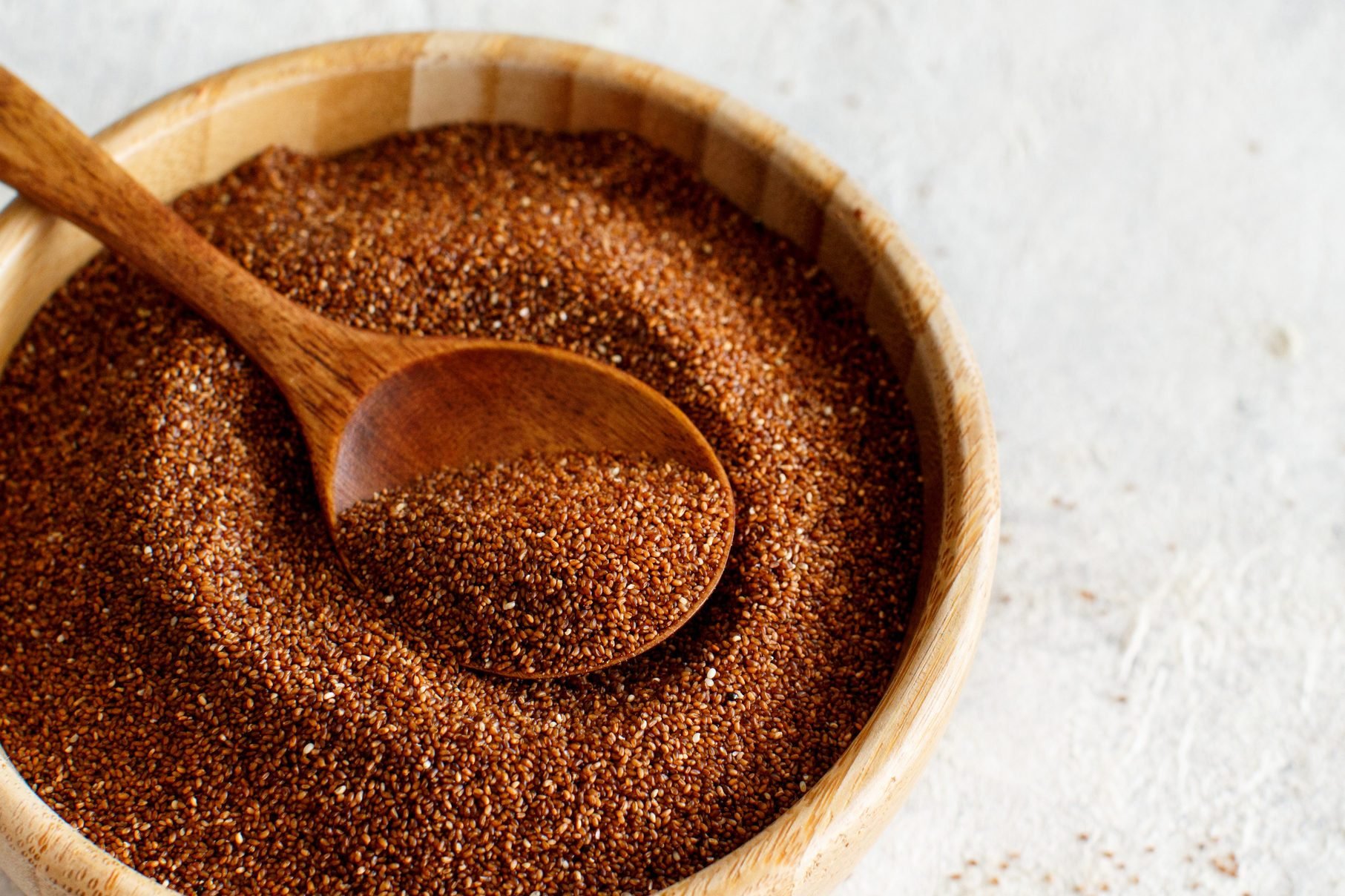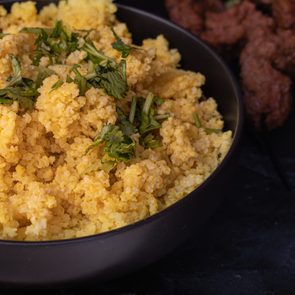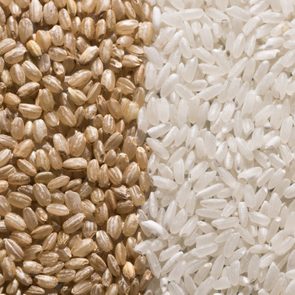What is Teff? What to Know About This Gluten-Free Ancient Grain
Updated: Aug. 10, 2021
Teff is a powerhouse seed full of essential amino acids, calcium, and other nutrients. Here are the health benefits of teff and how to include it in your diet.
What is teff?
If you’ve never heard of teff, you’re not alone. The Ethiopian gluten-free grain was banned for exportation by the Ethiopian government in 2006 because its rising popularity raised worries about a shortage—farmers couldn’t keep up with demand.
Since the ban was lifted in 2015, it’s been popping back up in supermarkets around the world.
If you enjoy Ethiopian food, you may have eaten teff without realizing it. It’s the main ingredient in the round, fermented spongy Ethiopian bread injera. The crepe-like flatbread is torn in pieces to scoop up savory stews in place of a spoon or fork.
Often considered a pseudocereal or grain because of how it’s eaten, teff (sometimes spelled tef) is actually a tiny seed—about the size of a poppy seed. Teff is more like quinoa, millet, or flaxseeds than wheat.
There are plenty of reasons to consider adding this food to your meals. Keep reading to learn more about teff, its nutrition, health benefits, and how to eat it.
Origins of teff
Teff is a staple crop native to Ethiopia and Eritrea. It’s also grown in South Africa and Australia as a cover crop—that is, to prevent soil erosion and put nutrients back into the soil, and cultivated for grazing animals.
In fact, up until recently, teff had only been grown in the United States as feed for horses. Farmers in some regions are now beginning to grow it for consumption.
Teff is a part of the grass family Poaceae, and its ability to grow in harsh climates and withstand droughts makes it a valuable and important crop. Apart from being a nutritious seed, it has a long shelf life, which is important when there are years with a less-than-ideal harvest.
The types of teff
There are more than 4,000 varieties of this nutritious seed. The seed is so tiny that 150 teff seeds are the equivalent of one grain of wheat.
Seeds range in color from ivory to mahogany to red. Teff flour is ground from ivory and white-hued seeds, while whole teff is often red or brown.

Health benefits of teff
Teff is naturally gluten-free
Celiac disease is an autoimmune disorder in which the body reacts to the gluten proteins found in barley, rye, and wheat. The condition damages the small intestine, causing bloating, diarrhea, fatigue, and even anemia, among other symptoms. (Although sometimes celiac disease can cause no obvious symptoms at all, even though damage is occurring.)
People with celiac disease have a higher risk of malnutrition, osteoporosis, and infertility, and need to completely eliminate gluten-containing food from their diets.
Because teff is a seed and has no connection to wheat, it’s naturally gluten-free. It’s a great option for anyone wanting to reduce the number of gluten-containing foods they consume. (Check the package, however. Some foods can become contaminated during manufacturing so make sure it’s labeled “gluten-free.”)
“Many of my clients have celiac disease or gluten sensitivities and are looking for more variety to the whole grains they include in their diet. Teff can be a nutritious, gluten-free addition to a person’s menu rotation,” says Danielle Gaffen, RDN, a San Diego–based registered dietitian nutritionist.
You can use teff flour in place of gluten-containing flour in many foods, including cookies, cakes, pancakes, muffins, and bread.
(Here’s how the body changes when you go gluten-free.)
It can also be a good option for people with other digestive issues. “Teff is easy to digest, which is great for people who may be more sensitive,” says Rachel Naar, RD, a registered dietitian based in New York City.
Good source of amino acids
Amino acids—the building blocks of protein—are compounds vital to our bodies. There are 20 types of amino acids, nine of which are considered essential, which means you need to get them from food because the body can’t manufacture them.
“Unlike wheat, teff is high in protein and has an excellent amino acid composition, providing eight of the nine amino acids essential for humans,” says Gaffen.
Contains resistant starch
Resistant starch is a type of carbohydrate that resists digestion in the small intestine and passes straight to the large intestine, where the fiber ferments. “This fiber feeds the ‘good’ bacteria in your large intestine and increases the production of short-chain fatty acids,” Naar explains.
A diet rich in resistant starch helps stabilize blood sugar as well as aid gastrointestinal health and gut integrity, according to Naar. Teff is high in fiber and is considered a source of resistant starch.
Helps manage blood sugar levels
The glycemic index ranks foods based on how quickly they cause blood sugar to rise. Foods with a low glycemic index, such as those high in fiber and protein, release glucose at a slow and steady pace and don’t cause large spikes in blood sugar.
High-glycemic-index foods, on the other hand, release glucose quickly and can cause blood sugar spikes.
“Teff has a relatively low glycemic index compared with many other grains: 57,” says Naar. “Because each teff seed is so small, it’s impossible [for the digestive system] to process it to the same degree as other grains. This means that it’s a whole grain and therefore has more fiber than more-processed grains, and so can help prevent spikes in blood sugar,” says Gaffen.
Contains calcium
Calcium is an important mineral for our bodies. It’s necessary for teeth and bone health as well as for our nerves and blood vessels. “Calcium is great for bone density, balances hormone irregularities, and helps with the regularity of heart rhythms,” explains Naar.
Teff can be a great choice if you want to increase your calcium intake or add new foods rich in calcium to your diet. A single cup has 123 milligrams (close to 10 percent of the daily value).
“Interestingly, it has more calcium than most other grains,” says Gaffen. “Teff has over five times more calcium than oatmeal per equal serving size.”
Teff nutrition facts
This small seed is a nutritional powerhouse with plenty of fiber, vitamins, minerals, and essential amino acids. “Other nutrients include B vitamins, iron, magnesium, zinc, manganese, and selenium,” says Gaffen.
Here’s what you’ll find in a half-cup (126 gram) serving of cooked teff, according to the U.S. Department of Agriculture.
Calories: 128 (6.5 percent of the daily value)
Protein: 4.9 (10 percent DV)
Fat: 0.82 g (1 percent DV)
Carbohydrates: 25 g (8.5 percent DV)
Fiber: 3.5 g (12.5 percent DV)
Calcium: 61.5 mg (4.5 percent DV)
Iron: 2.6 mg (14.5 percent DV)
Magnesium: 63 mg (15 percent DV)
Manganese: 3.6 mg
Potassium: 135 mg
Zinc: 1.4 mg
Risks or side effects
Teff is a nutritious seed worth tasting and could be a good addition to your meal rotation. But there are a few things to know.
“As with any high-fiber food, eating too much teff can cause gas and bloat,” says Naar.
If you bake with teff flour, you likely won’t get the same results as wheat flour. “Teff flour likely won’t rise much, so it would be ideal for baked goods that don’t need to rise much anyways, such as crepes or cookies. Also, note that teff baked products may not be as chewy,” says Gaffen.
As with other gluten-free flours, cooking with teff flour often requires a binding agent like the food additive xanthan gum or even wheat flour, Gaffen notes.
Teff does contain antinutrients—just like millet and amaranth—which are molecules that block or reduce the absorption of nutrients. The way you prepare teff flour can reduce the antinutrients.
Antinutrients for teff include phytic acid, Gaffen says. You can reduce this by mixing teff flour with water and letting the mixture sit at room temperature for a few days.
One caveat to using teff flour is the cost. “I let my clients know that teff flour may be more expensive than other gluten-free flours,” says Gaffen.
How to eat teff
Teff has an earthy, nutty flavor.
It’s highly versatile: In African countries, teff flour is an ingredient in an alcoholic beverage and beer, as well as the main ingredient in the Ethiopian bread injera.
You can use teff as a substitute for oatmeal to make porridge, as an alternative to rice in pilaf, or as a flour in gluten-free baked goods.
“Teff is very versatile, as you can steam it, boil it, or bake it. It can also be used with sweet or savory dishes,” says Gaffen. “Teff can be used as the grain in buddha bowls or grain salads, a filling in stuffed peppers, in soups—or practically anything else.”
Preparing teff is quick; it cooks a bit faster than white rice or quinoa. But the liquid-to-seed ratio is distinct. “The ratio is 1 cup teff to 3 cups water,” Naar says. For a creamy texture or to make a teff-style pilaf, the ratio may be closer to 1.5 cups to 1 cup teff.
Recipes
Simple Teff Pilaf
This lovely pilaf side dish (or main if you add some veggies or protein) comes courtesy of Gaffen.
Serves four
Ingredients
1 cup of teff
1.5 cups of chicken stock or bone broth
Directions
Rinse and drain the teff.
Bring stock to boil in a large saucepan.
Add teff, stir, and bring to a boil.
Reduce to a simmer, cover, and cook until the liquid is absorbed—about 10 minutes.
Remove from heat and serve.
Ginger Pear Teff Pancakes
Courtesy of Rachel Naar.
Servings: Makes 8-10 pancakes
Ingredients
1 cup of rice oat milk
Coconut oil or oil of choice
2 tbsp of ground flax (or 2 tbsp chia seeds) mixed with 1/4 cup of water (this will be considered a wet ingredient concoction for recipe purposes)
2 tbsp of honey
1 tsp of vanilla extract
1 cup of peeled and minced pear
1 cup brown teff flour
1/2 tsp cinnamon
1/2 tsp ginger
Directions
Slice pears (peel if you wish) and toss with cinnamon and ginger.
Melt some coconut oil in a pan and briefly sauté the pears. Set aside.
Mix dry ingredients together in one bowl, and wet in another.
Pour your wet ingredients into dry and whisk thoroughly.
Melt oil of choice on a new pan and pour batter onto pan (3 tbsp batter per pancake).
Scatter pears over pancakes before flipping.
Let cool slightly and enjoy!
Learn more about teff and other unfamiliar grains here.





















